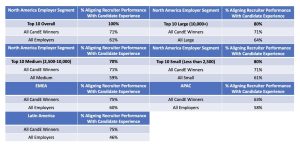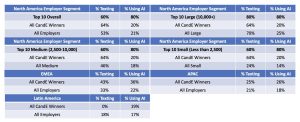The candidate experience outlook for 2024 is not great. At least, based on the 2023 CandE Benchmark Research features in the special report “Candidate Expectations Versus Employer Realities.”
When we were asked at the end of 2023 what we thought the recruiting and candidate experience trends were going to be in 2024, the only answer we were comfortable giving was this:
Candidate expectations across the candidate journey (pre-application to onboarding) will seemingly continue to increase, although year after year, most candidates simply desire timely acknowledgement and closure.
Unfortunately many employers big and small across industries will continue to marginally deliver recruiting and hiring experiences around the world. Ultimately, this will continue to drive candidate resentment — the percentage of candidates who will no longer be willing to apply again, refer others, have any brand affinity, or make purchases from a company that’s consumer-based.
We hope that you feel differently. We hope that you’re leaning in to improve your recruiting processes, optimize your recruiting technologies, and get your hiring managers on board with consistent and timely candidate communications.
In our annual candidate experience benchmark research, employers big and small across industries participate and survey their candidates about their experience. There are multiple ratings and rich data and insights that participating employers receive.
And what we glean each year is that there are those employers that have above average ratings. Why? What exactly are they doing differently? And are they doing things differently?
Each year we tell employers that even if they did deliver the greatest candidate experience in the world, at the point that they tell candidates, “No, we’re not moving forward with you,” their candidate experience ratings will skew negative — even if the candidates felt like it was positive and fair. Though at the same time, when people do feel it was positive and fair, they’re more likely to engage the business and the brand.
So, let’s get to some good news. Each year, we look more closely at the top 10 Candidate Experience (CandE) Award Winners in North America by overall ranking, and the top 10 by employer size, in addition to the highest-rated companies in the other regions we track (EMEA, APAC, and Latin America). Here are three differentiating examples of that we found in our global research.
Recruiter Accountability
Recruiting professionals have been through a lot the past few years since the pandemic, and 2023 was definitely a rough year with both involuntary and voluntary turnover on the rise. Recruiters are still the face of candidate experience, however, and the highest-rated employers are more likely to align recruiter performance with candidate experience. APAC CandE Winners had the smallest percentage of alignment, but it was still nearly 10% more than all participating APAC employers.
Using candidate experience as a signifier of performance demonstrates how important it is and incentivizes recruiters to maintain a good experience throughout the candidate journey.
Aligning Recruiter Performance With Candidate Experience

Recruiting Technologies
The highest-rated employers in 2023 tend to leverage recruiting technologies like texting and artificial intelligence to improve recruiting and the candidate experience, more than all other participating companies. Both texting and smart technologies can help improve communication and feedback loops with candidates throughout the candidate journey.
Moreover, the top 10 large and medium CandE Winners are more likely to use texting and artificial intelligence recruiting technologies in North America, with large employers leading the pack this year. EMEA and APAC CandE Winners are as well, but not in Latin America. This may be due to the much smaller number of participating employers and winners that aren’t fully representative of the region.
Texting and AI Technologies

Giving Finalist Feedback
We can’t emphasize enough the importance of giving feedback to finalists. Finalists getting feedback are 30% to 50% more willing to refer others than those who don’t get feedback. It truly is one of the biggest communication differentiators we see every year.
The top-rated employers, and all CandE winners for that matter, are giving more feedback to finalists than all other employers in our research. This is a tricky one for many companies, and one of the first questions we are asked about this is: What kind of feedback are you talking about?
We’re not talking about culture-fit feedback or anything else deemed “personal attributes.” No, we’re talking about job-fit and qualification-status feedback — the “why” the candidate didn’t get the job offer in the end.
Usually these responses are brief calls and/or emails that tell a candidate: “There were so many qualified finalists, including you, but in the end we went with another candidate because you didn’t have X, Y, or Z. We recommend you go get X, Y, and Z, and in the meantime, you might consider one of these other roles at our company [insert jobs].”
That’s oversimplifying the exchange, but the highest-rated employers are doing this consistently across job types and reaping referral benefits from it year after year.
Candidates Getting Feedback

Download “Candidate Expectations Versus Employer Realities” to review even more global differentiators. As we delve further into 2023’s CandE Benchmark Research (coming soon), it’s clear that improving and sustaining a quality candidate experience has been, and will continue to be, a struggle.
Even the CandE Winners this past year have candidate-communication timeliness slipping away from them because of the continuing hiring market volatility, team voluntary and involuntary turnover, lack of recruiting technology optimization, and constant business changes that ultimately impact recruiting and hiring delivery. But they still have the candidate experience edge, and that’s what we find each and every year.
